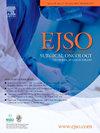Surgical resection for small (≤2 cm) gastric gastrointestinal stromal tumor
IF 3.5
2区 医学
Q2 ONCOLOGY
引用次数: 0
Abstract
Background
It is unclear whether surgical excision is the best course of treatment for small gastric gastrointestinal stromal tumor (GIST) ≤2 cm. The aim of this study was to evaluate the long-term survival results of surgical and non-surgical treatment for small gastric GIST.
Methods
Between 2000 and 2021, patients with small gastric GIST were chosen from the Surveillance, Epidemiology, and End Results (SEER) database. Propensity score matching (PSM) was used to mitigate selection bias in the comparison process. Kaplan-Meier analysis and multivariate Cox model were used to assess the effects of demographic and clinical characteristics on overall survival (OS) and cancer-specific survival (CSS).
Results
A total of 1229 patients with gastric GIST (≤2 cm) were included, including 1004 (81.69 %) patients who underwent operative management and 225 (18.31 %) who received non-operative management. The 5-year OS and CSS rates were compared between the two groups before PSM [5-year OS (83.51 % vs. 79.53 %, P < 0.001), 5-year CSS (96.96 % vs. 91.81 %, P = 0.017)]; after PSM [5-year OS (82.79 % vs. 80.00 %, P = 0.039), and 5-year CSS (94.88 % vs. 94.42 %, P = 0.398)]. Furthermore, after correcting for covariates, operative management was associated with a significant improvement in OS (HR = 0.62, 95 % CI 0.40–0.97, P = 0.037), while no significant effect on CSS was observed (HR = 0.85, 95 % CI 0.43–1.70, P = 0.643).
Conclusions
Our analysis demonstrated a statistically significant association between operative management and improved OS for small gastric GIST (≤2 cm).
胃胃肠道间质小瘤(≤2 cm)手术切除
背景对于≤2 cm的胃肠道间质小肿瘤,手术切除是否为最佳治疗方案尚不清楚。本研究的目的是评估手术和非手术治疗小胃间质瘤的长期生存结果。方法从监测、流行病学和最终结果(SEER)数据库中选择2000年至2021年期间的胃小间质瘤患者。采用倾向得分匹配(PSM)来减轻比较过程中的选择偏差。采用Kaplan-Meier分析和多变量Cox模型评估人口学和临床特征对总生存期(OS)和癌症特异性生存期(CSS)的影响。结果共纳入胃间质瘤(≤2 cm)患者1229例,其中手术治疗1004例(81.69%),非手术治疗225例(18.31%)。比较两组患者PSM前5年OS和CSS率[5年OS (83.51% vs. 79.53%, P <;0.001), 5年CSS(96.96%比91.81%,P = 0.017)];后PSM(5年OS(82.79%比80.00%,P = 0.039),和5年CSS(94.88%比94.42%,P = 0.398)]。此外,校正协变量后,手术管理与OS的显著改善相关(HR = 0.62, 95% CI 0.40-0.97, P = 0.037),而对CSS无显著影响(HR = 0.85, 95% CI 0.43-1.70, P = 0.643)。结论sour分析显示,小胃间质瘤(≤2 cm)手术处理与OS改善有统计学意义。
本文章由计算机程序翻译,如有差异,请以英文原文为准。
求助全文
约1分钟内获得全文
求助全文
来源期刊

Ejso
医学-外科
CiteScore
6.40
自引率
2.60%
发文量
1148
审稿时长
41 days
期刊介绍:
JSO - European Journal of Surgical Oncology ("the Journal of Cancer Surgery") is the Official Journal of the European Society of Surgical Oncology and BASO ~ the Association for Cancer Surgery.
The EJSO aims to advance surgical oncology research and practice through the publication of original research articles, review articles, editorials, debates and correspondence.
 求助内容:
求助内容: 应助结果提醒方式:
应助结果提醒方式:


